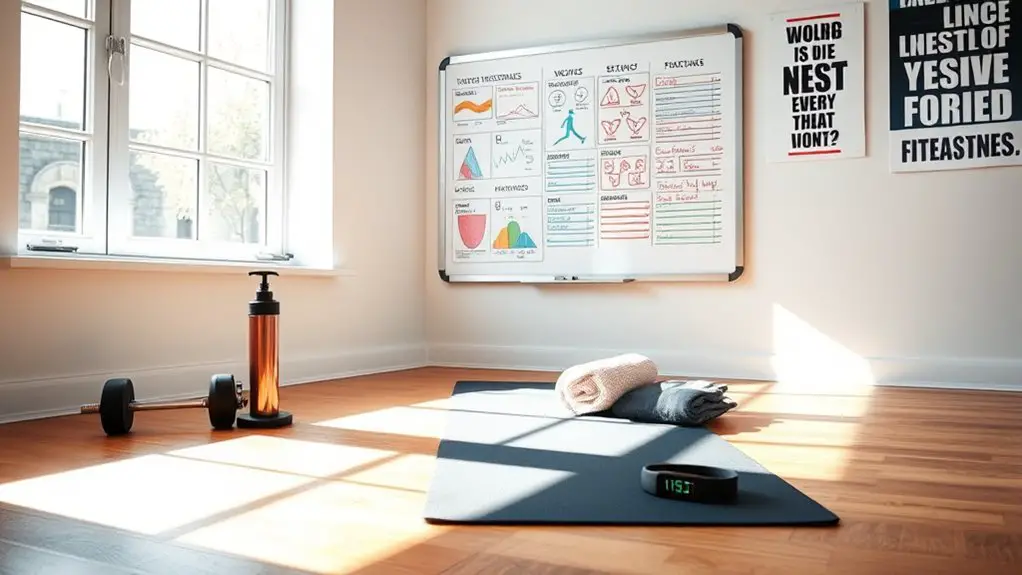How to Create a Custom Gym Routine

To create a custom gym routine, start by evaluating your current fitness level and defining clear goals. Choose how often you’ll work out and pick exercises you enjoy, ensuring a mix of strength, cardio, and flexibility work. Schedule your workouts consistently and track your progress to stay motivated. Don’t forget to adjust your routine as needed to keep things fresh and challenging. There’s more to explore to make your fitness journey effective and enjoyable.
Assess Your Current Fitness Level

How do you know where to start if you don’t assess your current fitness level? Conducting fitness assessments is essential for understanding your strengths and weaknesses. Start with a strength evaluation to gauge how much weight you can lift comfortably. This helps identify your baseline and prevents injury by ensuring you don’t overexert yourself.
You can also evaluate your endurance through simple exercises like timed runs or cycling. Flexibility tests, such as reaching for your toes, provide insight into your mobility. Remember, the goal isn’t to push your limits right away; it’s about gathering data to craft a safe and effective routine. Additionally, incorporating general benefits of skipping can enhance your overall fitness routine.
Always listen to your body during these assessments. If something feels off, it’s best to consult with a fitness professional. Taking the time to assess your current fitness level lays a solid foundation for your gym routine, ensuring you progress safely and effectively.
Define Your Fitness Goals
To create an effective gym routine, you first need to define your fitness goals. Think about what you want to achieve and set specific objectives that align with your current fitness level. It’s also important to set realistic timelines to keep you motivated along the way.
Identify Specific Objectives
What do you want to achieve with your gym routine? Identifying specific objectives is vital for your success and safety. Whether you’re aiming for muscle gain or weight loss, clear goals help you stay focused and motivated. Start by thinking about how much muscle you’d like to build or the weight you’d like to lose. Make sure your targets are realistic and time-bound to keep you accountable. For example, consider setting a goal to lose one pound per week or gain a specific number of pounds in muscle over a few months. Remember, it’s essential to prioritize your health throughout this journey. With well-defined objectives, you’ll have a roadmap to follow, making your gym experience more enjoyable and effective.
Assess Current Fitness Level
Before diving into your gym routine, it’s important to assess your current fitness level, as this knowledge will guide your goals and help you avoid injury. Start by conducting fitness assessments to understand your strengths and weaknesses. Here are some key performance metrics to examine:
- Cardiovascular Endurance: Measure how long you can sustain physical activity.
- Muscular Strength: Test your ability to lift weights or perform bodyweight exercises.
- Flexibility: Evaluate your range of motion through stretches or yoga poses.
- Body Composition: Check your body fat percentage and muscle mass.
Understanding these metrics will help you set realistic, achievable goals tailored to your fitness level, ensuring a safer and more effective workout experience.
Set Realistic Timelines
Setting realistic timelines for your fitness goals is essential, especially if you want to stay motivated and track your progress effectively. It’s important to set realistic expectations about what you can achieve in a given timeframe. Instead of aiming for drastic changes, focus on incremental improvements that foster long-term success. For example, instead of planning to lose 20 pounds in a month, consider a goal of 1-2 pounds a week. This approach allows for better timeline management and reduces the risk of injury or burnout. Remember, consistency is key, and small, steady progress is safer and more sustainable. Adjust your timelines as needed, and celebrate each milestone to keep your motivation high!
Choose Your Workout Frequency
When it comes to choosing your workout frequency, you need to assess your schedule honestly. Think about your fitness goals and how much time you can realistically commit each week. Finding the right balance will help you stay consistent and motivated on your journey.
Assess Your Schedule
How often can you realistically fit workouts into your week? Evaluating your schedule is essential for maintaining a healthy work-life balance and effective time management. Be honest about your commitments and prioritize your health. Here are some tips to help you determine your workout frequency:
- Identify your available days: Consider your work and personal obligations.
- Gauge your energy levels: When do you feel most motivated to exercise?
- Start small: Aim for shorter workouts initially, then gradually increase duration and frequency.
- Schedule workouts: Treat them as important appointments to guarantee consistency.
Consider Fitness Goals
What do you want to achieve with your fitness routine? Understanding your fitness goals is essential for effective goal prioritization. Whether you aim to lose weight, build muscle, or improve endurance, your workout frequency should align accordingly.
Here’s a visual guide to help you choose:
| Goal Type | Recommended Frequency | Motivation Techniques |
|---|---|---|
| Weight Loss | 4-5 times/week | Set small milestones |
| Muscle Gain | 3-4 times/week | Track progress visually |
| Endurance | 3-6 times/week | Join a group or class |
| Maintenance | 2-3 times/week | Reward yourself |
Select Your Preferred Types of Exercise

Ever wondered which types of exercises you enjoy most? Finding what suits you can make your fitness routine enjoyable and effective. Consider exploring various options to see what resonates with you. Here are some categories to think about:
- Yoga styles: From gentle Hatha to invigorating Vinyasa, there’s a yoga practice for everyone.
- Cardio options: Whether it’s running, cycling, or swimming, choose activities that get your heart pumping.
- Strength training: Incorporate weights or resistance bands for building muscle and increasing strength.
- Flexibility exercises: Include stretches to enhance mobility and prevent injuries.
You might prefer group classes for motivation or outdoor activities to enjoy nature. Whether you lean towards high intensity or low impact, the key is to choose exercises that feel safe and enjoyable for you. This will help you stay committed to your custom gym routine. Adding elements like jump rope workouts can also engage your core muscles effectively while keeping your routine interesting.
Create a Balanced Workout Plan
To create a balanced workout plan, it’s essential to incorporate a mix of cardiovascular, strength, flexibility, and balance exercises. Start with cardio to boost your heart health—activities like walking, cycling, or swimming can do wonders. Aim for at least 150 minutes a week, but listen to your body and adjust as needed.
Next, integrate strength training at least two days a week. Focus on major muscle groups using weights, resistance bands, or bodyweight exercises. This not only builds muscle but also supports bone health.
Integrate strength training twice a week to build muscle and support bone health effectively.
Don’t forget about flexibility and balance! Incorporate stretching routines and exercises like yoga or Pilates to enhance mobility and prevent injuries. Balance exercises, such as standing on one leg or using a stability ball, can improve your overall stability, which is crucial for safety. Additionally, consider consulting a personal trainer to help tailor your routine to your individual needs and goals.
Combining these elements will lead to a well-rounded fitness routine that promotes long-term health and wellness.
Schedule Your Workouts

While it may seem challenging to fit workouts into a busy schedule, planning your workouts can make all the difference. By prioritizing time management, you’ll achieve workout consistency and keep your fitness goals on track. Here are some tips to help you schedule effectively:
- Choose specific days and times for your workouts and treat them as appointments.
- Set reminders on your phone to help you stay accountable.
- Be flexible; if you miss a session, reschedule instead of skipping.
- Start small; even short workouts can be effective, so don’t feel pressured to go for long sessions. Remember that taking breaks is acceptable, but consistency in workouts is crucial to maintain fitness levels.
Track Your Progress
Tracking your progress is essential for staying motivated and ensuring you’re on the right path to achieving your fitness goals. One effective way to do this is by maintaining a fitness journal. In this journal, you can log your workouts, noting the exercises, weights, sets, and reps. This not only helps you see how far you’ve come but also allows you to identify patterns and potential areas for improvement.
Regular progress tracking can also help you stay accountable to your routine. By reviewing your entries, you’ll be more aware of what’s working and what might need adjustment. Remember to include how you feel during different workouts, as this can provide insights into your overall well-being and safety. Ultimately, a fitness journal is a valuable tool that can enhance your journey and keep you motivated as you work toward your goals. Additionally, monitoring your body composition changes can be a key indicator of your progress.
Adjust Your Routine as Needed
As you track your progress, it’s important to remember that flexibility in your routine can lead to better results. You might find that adjusting intensity or modifying exercises is necessary to keep things effective and safe. Listen to your body and be open to change.
Here are some tips for adjusting your routine:
- Reassess goals: If your objectives shift, your routine should too.
- Adjust intensity: If you’re consistently completing your workouts with ease, consider increasing weights or reps for more challenge.
- Modify exercises: If something doesn’t feel right or causes pain, swap it out for a safer alternative.
- Incorporate rest days: Listen to your body’s need for recovery, adjusting your schedule to prevent burnout. Additionally, proper form is essential to ensuring that any changes made to your routine do not lead to injury.
Frequently Asked Questions
How Do I Stay Motivated to Stick to My Routine?
Staying motivated can be tough, but setting clear goals is a great start. Break your bigger goals into smaller, achievable ones, so you can celebrate progress along the way. Finding an accountability partner can also help—you’ll encourage each other and stay on track. Remember, it’s important to prioritize your safety and well-being as you work towards your goals. Keep things enjoyable, and don’t hesitate to adjust your routine if needed!
What Should I Do if I Miss a Workout?
Life’s unpredictable, right? If you’ve missed a workout, don’t stress. Just remember, workout flexibility is key to a sustainable routine. Instead of dwelling on what you missed, think about how you can adjust. Perhaps squeeze in a quick session later or modify your plans for the week. It’s all about balance and keeping your goals in sight. Prioritize safety, listen to your body, and keep moving forward—you’ve got this!
How Can I Prevent Workout Injuries?
To prevent workout injuries, you need to prioritize injury prevention strategies. Start each session with proper warm up techniques, like dynamic stretches or light cardio, to prepare your muscles. Listen to your body; if you feel pain, don’t push through it. Gradually increase intensity and always use the correct form. Incorporating rest days into your routine is essential, too. By taking these steps, you’ll reduce the risk of injury and stay safe while training.
Should I Consult a Trainer for My Routine?
Consulting a trainer for your routine is like having a secret weapon in your fitness arsenal. The trainer benefits are immense; they provide personalized guidance tailored to your unique needs and goals. With their expertise, you can guarantee you’re exercising safely and effectively, minimizing the risk of injury. If you’re serious about achieving your fitness dreams without setbacks, getting professional advice is a smart move you won’t regret.
Can I Adjust My Routine for Home Workouts?
Absolutely, you can adjust your routine for home workouts! When you’re working with home equipment, consider the space you have available. Make certain your workout area’s safe and free from hazards. You might want to incorporate bodyweight exercises if you lack equipment. Also, remember to maintain proper form to prevent injuries. Tailor your routine to fit your space and equipment, making it effective and enjoyable while keeping safety a priority.





